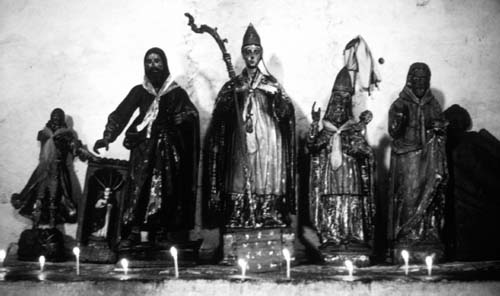ChristianitySigns and Symbols |
What are santos? |
Walk into virtually any small neighborhood or village church anywhere in Latin America and you will find santos. Santos (Spanish for “saints”) are small carved, painted statues of holy persons specially revered because of their spiritual power and presence. You will generally see them lined up on shelves along the side walls of the church or occupying small side altars flanking the main altar. All who come to the church regularly are likely to have a particular favorite among the diminutive saints. Devotees are not shy about expressing their needs to their patrons and these little churches are often alive with voices communicating in loud whispers every conceivable physical and spiritual need. People often light candles, soften the wax on the bottoms so that they will stick to the floor, and proceed to harangue their santos with animated gestures, humbly demanding rain for the crops or asking why a sick child has not yet been healed. Santos are an important form of folk religious art that reveals a great deal about popular Christianity in the Americas. Cathedrals and wealthier churches have their equivalent of santos in their multiple side altars and shrines, but there the conversations are quieter, the candles mounted on racks, and the saints often protected behind glass.

Statues of patron saints, known popularly as “santos,” lined up along a wall in the small Maya village church of Santiago Atitlan on the shores of Lake Atitlan in Guatemala. Devotees regularly visit, place candles, and engage in animated conversations with their patrons or saintly figures known for certain healing or other special powers.
